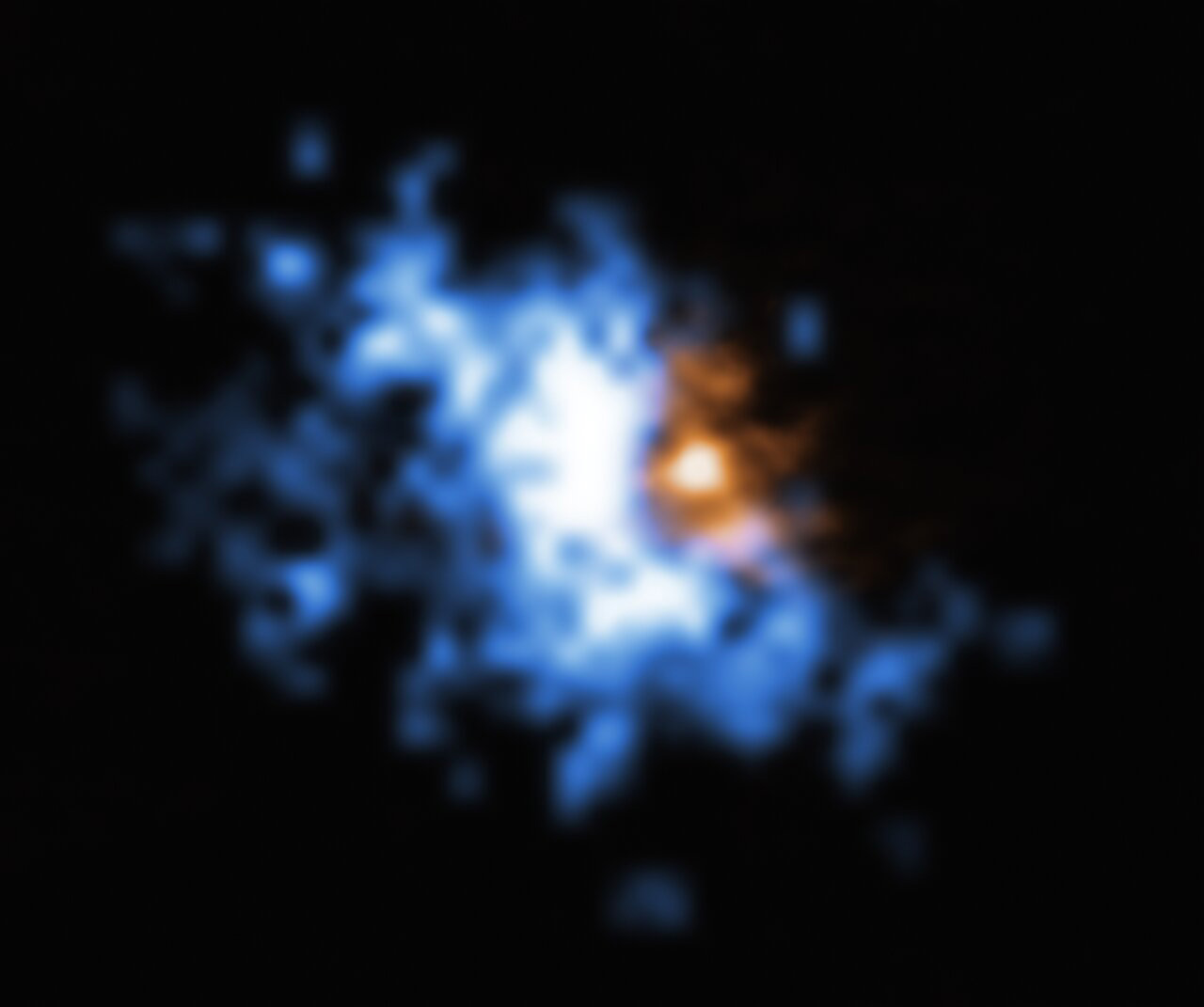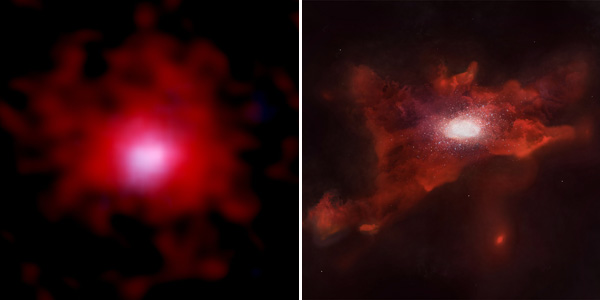A pair of recent studies sheds light on how cool gas flows in (and out) of young galaxies as they grow.
Astronomers peering back in time see galaxies that are miniature versions of the ones we see in the modern-day universe. But don’t be fooled by their size — these compact young galaxies are firecrackers, bursting with new stars and hosting supermassive black holes. Two independent groups of astronomers examine galaxies that existed when the universe was only a billion years old to find out how such young galaxies grow.
Flashlight Quasars
One team of astronomers, led by Emanuele Paolo Farina (Max Planck Institute for Astronomy in Heidelberg, Germany), homed in on quasars between 830 million and 1 billion years after the Big Bang.
The gas feeding a galaxy’s central black hole lights up as it falls in, acting as a flashlight that shines on the quasar’s pantry of neutral hydrogen gas. This gas is nearly invisible, but when it’s irradiated by the quasar’s ultraviolet light it shines at a particular wavelength known as Lyman-alpha (121.6 nanometers).

ESO / Farina et al.; ALMA (ESO / NAOJ / NRAO) / Decarli et al.
Using the Multi-Unit Spectroscopic Explorer (MUSE) on the European Southern Observatory’s Very Large Telescope, Farina and his colleagues looked for Lyman-alpha blobs (yup, that’s a technical term) around 31 quasars, publishing their results in an upcoming Astrophysical Journal (preprint available here). Almost half of these quasars had lit up a Lyman-alpha larder that’s more than enough to provide for the galaxy’s growth.
“We are now able to demonstrate for the first time that primordial galaxies do have enough food in their environments to sustain both the growth of supermassive black holes and vigorous star formation,” Farina explains.
The findings fall in line with the idea that these young galaxies grew on a steady diet of diffuse, neutral hydrogen gas clouds. This is expected from cosmological simulations, says Andrew Benson (Carnegie Institution of Science).
Carbon Cocoons
Another team of astronomers, this one led by Seiji Fujimoto (University of Tokyo, Waseda University, and National Astronomical Observatory of Japan), examined young galaxies from another angle. Excluding those with gas-guzzling black holes, the team focused instead on galactic star-forming factories.
Using observations taken with the Atacama Large Millimeter/submillimeter Array (ALMA) in Chile, the team found that clouds of gas rich in ionized carbon surrounded all 18 galaxies in their sample. These clouds extend out to 30,000 light-years, well beyond the stars in the galaxies themselves. The results appear in the December 20th Astrophysical Journal (preprint available here).

Left: ALMA (ESO / NAOJ / NRAO), NASA / ESA Hubble Space Telescope / Fujimoto et al.; Right: NAOJ
Unlike the Lyman-alpha blobs, which represent hydrogen gas that will eventually flow into growing galaxies, the carbon-rich cocoons around these star-forming galaxies are being pushed out, perhaps by stellar winds or by supernova explosions. Whatever is doing the pushing, it’s vital for spreading around the heavier elements that formed inside stars.
“We are witnessing this ongoing diffusion process, the earliest environmental pollution in the universe,” says coauthor Rob Ivison (European Southern Observatory and University of Edinburgh, UK).
While Lyman-alpha blobs are expected from cosmological simulations, which predict that infalling gas clouds help young galaxies grow, the large carbon-rich halos are a surprise. The results suggest that simulations might be missing some of the details associated with star-driven outflows.
The vast distance that separates us from the universe’s youngest galaxies makes the complex interplay between inflowing and outflowing gas difficult to understand. MUSE and ALMA are among the instruments that will help us disentangle their stories.
 0
0









Comments
You must be logged in to post a comment.